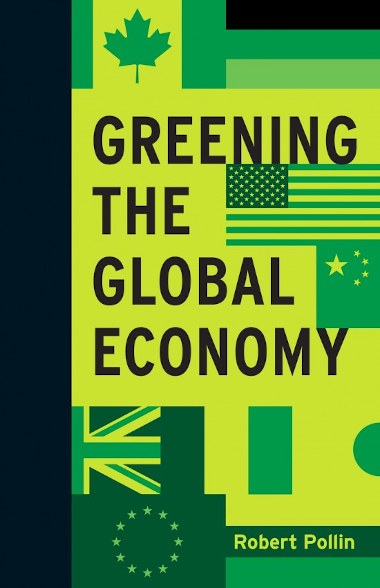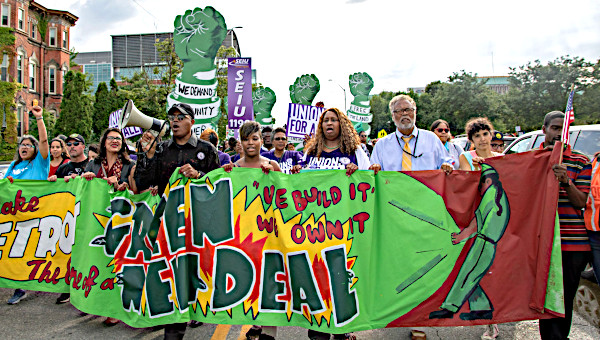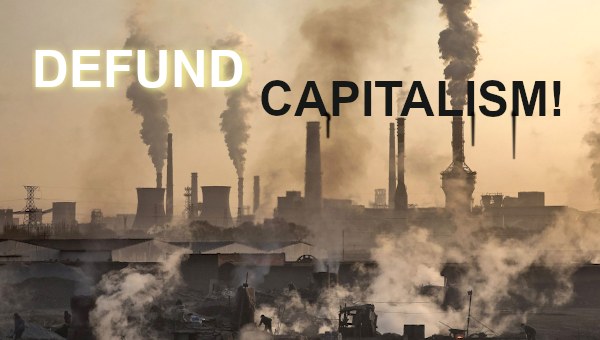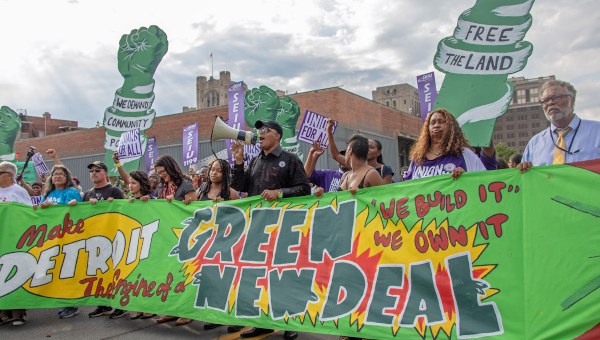The Climate Crisis, Degrowth and a Global Green New Deal (part 2)
As we move toward the COP26 UN meetings on climate change in Glasgow in November, debate is intensifying over the political coalitions and policy mechanisms to address the mounting climate emergency. The 6th Report of the Intergovernmental Panel on Climate Change released earlier this year, (Climate Change 2021: The Physical Science Basis) documented the global rise in temperature of the land, oceans, and atmosphere from concentrations of greenhouse gases produced by human activities from 1750. Since 2011, concentrations have continued to increase in the atmosphere and are now pushing past 410 ppm for carbon dioxide (CO2) annually alone (not including the rise in methane and nitrous oxide). Compared to any other decade since 1850, “each of the last four decades has been successfully warmer.”
The consequences have been many and alarming – the norming of extreme weather events, the melting of the polar ice shields, mass numbers of climate refugees, endless droughts, and more. The strategies being put forward by states and the ruling classes have been targeted at just coping and limiting the impacts through market mechanisms that will not merely maintain capitalist social property relations but, in fact, extend them through various mechanisms of ‘market ecology’ – incentives and subsidies for capitalists and consumers to move to alternate energy sources, shifts in relative prices, carbon taxes, commodifying more of the planet and the like, creating more markets to manage with the ecological problems that capitalism itself produced.
Debates on alternatives that would move beyond neoliberal and market measures vary. One set tended toward strategies for increased state-led transformations that would lead to greater controls over markets as part of a more egalitarian growth process. Others call for ‘degrowth’ to more radically break with economies centred on the endless accumulation of capital and commodification of life. A third group are proposing a more radical anti-capitalist rupture with capitalism to democratize and remake the social-production system and place a social ecology at the centre of decision-making.
In cooperation with Green Social Thought, Znet and Truthout, we present in three parts an exchange between Robert Pollin, C.J. Polychroniou, and Don Fitz. Part 2 is an exchange between Fitz and Pollin on the contradictions between a transition to renewable energy sources from fossil fuels, jobs, and meeting climate change targets within capitalist markets. Pollin is the progressive economist most central to strategies for a Green New Deal in the US. Don Fitz is a university lecturer, and editor with Green Social Thought, and a past candidate for the US Green Party.

Be Careful What Energy You Wish For
Climate change is an existential problem confronting humanity, and Robert Pollin offers well thought-out plans in part 1 of this exchange. There is only space here to respond to these themes: (1) We can reach zero CO2 emissions by 2050; (2) An enormous expansion of alternative energy (AltE) can create far more jobs than would be lost by eliminating fossil fuels (FF); and (3) Without stating so explicitly, he implies that negative aspects of AltE would be tiny.
Unfortunately, the downsides of AltE loom so large that they must form the core of any serious discussion. Like many proponents of AltE, Pollin does not present climate change as symptomatic of capitalist overproduction, but as a stand-alone crisis whose resolution may require strengthening capitalism. Yet, there is already more than enough manufactured production to meet the needs of humanity, if only manufacturing were shifted from creating what is wasteful and destructive to production for need.
The rush to massively expand AltE ignores what environmentalists have known for decades. Redesigning cities to create walkable communities is vastly more ecological than subjecting children in the Democratic Republic of Congo to the horrors of cobalt mining for electric vehicles. Humanity can reduce its footprint by consuming much less meat and relying on local food rather that transporting the average bite 1700 miles. Americans do not need housing space vastly exceeding that of anywhere else in the world (except Australia). Buildings can be altered for reuse instead of constant tear-down rebuilding. Manufacturing standards can be set to require the maximum life for goods rather than subjecting people to the message of “Buy, Buy, Buy!” as corporations design products to fall apart and go out of style. Humanity does not need more crap – corporations do.
Rather than exploring these, Pollin labors to satisfy the corporate urge for infinite growth via “clean, renewable” energy sources of solar, wind, “small-scale hydro,” and “low-emissions bioenergy.” It is also necessary to point out that achieving a “zero emissions economy” by 2050 is a disingenuous goal. The life cycle of AltE requires FFs for construction equipment, mining for essential minerals, transportation, and disposing of the energy harvesting equipment. Wind and solar are intermittent, which means they require backup (often gas) for emergencies.
Solar Power
In addition to health problems from extraction, manufacturing, and disposal, there are issues of those who would be affected. Greg Wagner recently wrote me …
“I live in a small rural farming community known as Goldendale, Washington, in Klickitat County on the east side of the state. I formed the group Citizens Educated about Solar Energy (CEASE) when I learned by accident the solar companies’ plans. My home and many others are surrounded by tens of thousands of acres of wheat/alfalfa/hay fields and beautiful views of Mt. Adams, Mt. St. Helens, and Mt. Hood. This will all be destroyed if our county commissioners allow Invenergy and Cypress Creek Renewables to build their proposed solar sites on the 10,000 acres we know about…”
On the other side of the US, citizens in Culpepper County, Virginia, blocked a proposal by Maroon Solar. The planning board said that “the project was out of character with the area, too large, and would be injurious to the health and safety of area residents.” Opponents also commented that “the utility-scale project would ruin the rural nature of the area, the environment, and historic resources.”
Wind Power
Health problems also appear with wind, and victims of its placement are often unhappy. Opponents halted wind turbines in Reno County, Kansas. As in other areas, a major concern was having wind turbines too close to people. As Patrick Richardson reported, “The setback is often no more than double – sometimes just one and a half times – blade height, meaning turbines can be within as little as 500 feet away from a school, as in Labette County.”
Showing that the problem is international, Shivani Gupta writes of 1000 villagers in the Kachchh district of India who protested plans to put industrial wind turbines in portions of the Sangnara forest and adjacent common grazing areas where farmers bring their cows and sheep. “The Sangnara forest is home to a huge diversity of endangered flora and fauna. This includes chinkara, wolf, caracal, ratel, hyena, desert cat, Indian fox, spiny tailed lizard, desert monitor, white-naped tit, vultures, and many more.”
“Small Scale” Hydro
Such power comes from dams with a capacity of less than 30 MW. While these dams are individually less destructive than mega-dams, a much, much larger number would be needed to provide power for an incessantly growing capitalism.
At 22 MW capacity, the Agua Zarca hydro-project in Honduras was “small-scale.” Berta Cáceres won the 2015 Goldman Environmental Prize for organizing the Lenca people along with other indigenous groups and the Afro-Honduran Garifunas to oppose the dam. The following year she was murdered by those who stood to profit from “clean, renewable energy.” In addition to being sacred, “the Gualcarque River is a primary source of water for them to grow their food and harvest medicinal plants. Dams can flood fertile plains and deprive communities of water for livestock and crops.”
“Low-Emissions” Bioenergy
Burning organic material is now the rage in Europe. In April 2021, climate scientists James Dyke, Robert Watson, and Wolfgang Knorr, who had formerly supported plans for “net-zero” emissions did an about-face as they wrote about its latest version, Bioenergy Carbon Capture and Storage, or BECCS:
“… rather than allow ecosystems to recover from human impacts and forests to regrow, BECCS generally refers to dedicated industrial-scale plantations regularly harvested for bioenergy rather than carbon stored away in forest trunks, roots and soils. Currently, the two most efficient biofuels are sugarcane for bioethanol and palm oil for biodiesel – both grown in the tropics. Endless rows of such fast growing monoculture trees or other bioenergy crops harvested at frequent intervals devastate biodiversity. It has been estimated that BECCS would demand between 0.4 and 1.2 billion hectares of land. That’s 25% to 80% of all the land currently under cultivation.”
BECCS can also include burning wood pellets. Land Institute research scientist Stan Cox observes: “This process is not emissions-free; in fact, wood-fired power plants produce more pollution per kilowatt-hour of electricity than coal-fired plants.” Even if BECCS were used to capture those emissions, Cox notes that, “… the process’s many steps – producing and harvesting biomass crops, hauling the biomass to the processing factory, grinding and pelletizing, hauling pellets to the power plant, sucking carbon dioxide out of the smokestack, liquefying the carbon dioxide, hauling the liquid to the injection field, and shooting it into the earth under high pressure – would, in sum, eat up large quantities of energy.”
Jobs
Once we realize both that AltE has devastating consequences and that humanity can exist quite well without the unnecessary production, a critically important question remains: Will using much less energy leave tens of millions of people unemployed? After all, ensuring full employment during a just economic transition must be a central goal of coping with climate disaster. The answer is provided to us by centuries of labor activists who have demanded a shorter work week. FDR was president the last time that labor considered a 30-hour work week in the US. Why in the world should we work more hours to destroy the lives of our descendants?
Caps
One of the most astounding aspects of the Green New Deal (GND) is that, despite understanding by its supporters that FFs must be reduced, none of the Democratic Party versions of the GND include a cap on the amount of FFs that can be produced. They imply that increasing AltE will cause FF use to decline, which is completely false. The capitalist state will ensure that AltE is added to the mix. As Cox notes succinctly: “The purge of oil, gas, and coal must be done directly, by law.”
Questions
Given that dangers of AltE are real, large, and growing, these are questions that its adherents should answer:
- Do they acknowledge that the intermittency of solar and wind power requires FF backup and that
FFs are required for mining (extraction), material and waste transportation, construction, operation and disposal, meaning that zero FF usage is unrealistic? - If they recognize that AltE is thick with health and environmental problems throughout its life cycle, do they agree that it should not be described as “clean?”
- Knowing that Bernie Sanders and the Democratic Party “Squad” do not call for limits on producing and burning FFs, do they part company with them in calling for caps to be quantified for specific dates?
Contradictions
Jonathan Cook realizes that “it is quite possible – common, in fact – for us to hold contradictory beliefs at the same time: like worrying about the threat posed to our children’s future from climate change, while supporting political systems committed to building more roads and runways.” An increasing number of people are overcoming this psychological dilemma as they realize the fallacy of “solutions” that intensify problems. Circular destruction occurs when hotter weather leads to more air conditioning, which causes more energy production for electricity, which causes more climate change and increased heat. It cannot be said too many times: the fundamental challenge today is to reduce production while increasing the quality of life. This capitalist crisis of overproduction cannot possibly be solved by increasing production. •
A version of this article was first published on Green Social Thought.org.
An Egalitarian Green New Deal Is the Necessary Path to Climate Stabilization: Response to Don Fitz
Don Fitz’s response to my interviews in part 1 of this exchange makes two major assertions: 1) Reducing overall consumption and working fewer hours provides a viable path on its own to stabilizing the global climate; and 2) Renewable energy sources, such as solar and wind power, are not really “clean” even though they supply energy without generating CO2 emissions. I will address these in turn.
As I state at the outset of my first posted interview, on ‘degrowth’, I strongly agree that “a significant share of what is produced and consumed in the current global capitalist economy is wasteful, especially much, if not most, of what high-income people throughout the world consume.” Fitz is merely setting up a straw-person in suggesting that I think otherwise.
More pertinently, Fitz seems to believe that we can move the global economy onto a viable climate stabilization path if we all consume less, work fewer hours, and eat less meat, while also shortening global supply chains and making cities more walkable. This appears to be the case, in his view, even if we do not transform our global energy system from one dominated by fossil fuels to one dominated by sources that are CO2-emissions free. He offers no evidence to support his position. In fact, there is no evidence that supports his position.
To get into some specifics, the world economy emitted about 34 billion tons of CO2 into the atmosphere as of the most recent 2018 data. Most of these emissions result through burning oil, coal, and natural gas to produce energy. The IPCC has said that we need to cut these emissions from burning fossil fuels by about 50 percent as of 2030 – only a little more than 8 years from now – and to be at net zero emissions by 2050.
I, myself, have always strongly emphasized, including in both the interviews posted at Z, the centrality of investments to raise energy efficiency standards throughout the world. That means, among other things, significantly upgrading the heating, lighting, cooling, and insulation equipment in buildings, greatly expanding public transportation systems, and producing much more efficient private vehicles. However, even if we make these critical investments to raise efficiency standards, at best we will be able to reduce global energy consumption in the range of 5 – 10 percent. This assumes, as I said in the degrowth interview, that “people are still going to need to consume energy to light, heat and cool buildings, to power cars, buses, trains, and airplanes and to operate computers and industrial machinery, among other uses.”
In particular, I strongly favor, as part of any minimally decent global egalitarian program, a significant increase in access to energy for lower-income people in all regions, to enable them to raise their living standards. I not think that Fitz’s claim that “humanity does not need more crap” applies to the roughly 70 percent of the world’s population – 5.5 billion people – that lives on less than $10 a day. It is critical to be able to provide, for example, warm, well-lit living spaces, high-quality public transportation, and access to the internet as efficiently as possible for this overwhelming majority of humanity.
Fitz appears to believe, without providing evidence, that we can cut global energy consumption by far more than 5 to 10 percent without cutting the living standards of low-income people. But let’s note that even if we were to cut global energy consumption by, for example, an implausible 50 percent by consuming “less crap” and working fewer hours, we would still be only half way to bringing CO2 emissions down to zero, as long as we maintain intact our current fossil fuel-dominant energy infrastructure.
In short, there is simply no getting around the fact that we need to supplant our existing fossil-fuel dominant energy system that is the main cause of the global climate crisis with an alternative system that delivers abundant energy without generating CO2 emissions. This is where renewable energy becomes critical. Of course, there are significant challenges to address in building out a global renewable-dominant energy system. But none of these challenges are insurmountable, as Fitz suggests. For example, Fitz cites the obvious matter of intermittency with solar and wind power – that the sun isn’t always shining and the wind isn’t always blowing at any given location. But this problem can be solved through continuing to make advances in battery storage and electricity transmission systems. It is also the case that other renewable sources – geothermal, hydro, and low-emissions bioenergy – are not intermittent. They can serve as supplemental energy sources in combined renewable energy systems.
Fitz also asserts that building the renewable energy infrastructure can only be accomplished by consuming more fossil fuel energy. This is not true. As the supply of renewable energy expands, the full range of industrial machinery, transportation equipment, and computers can all be powered through renewable energy sources just as well as, if not better than, through fossil fuel energy.
Fitz cites examples of renewable energy projects being built in ways that disrupt communities and natural habitats. Such concerns are valid. The land-use issues around building a renewable energy infrastructure need to be addressed with great care and democratic decision-making. But as a general proposition, it is useful to start from the calculations of the Harvard University physicist Mara Prentiss that with the US as a high-efficiency economy, more than half of this necessary surface area could be provided through locating solar panels on rooftops and parking lots throughout the country. 2 Beyond this space provided by rooftops and parking lots, solar energy sources using existing technologies could supply 100 percent of US energy demand while consuming somewhere between 0.1 and 0.2 percent of additional US land area.
If Fitz is convinced that renewable energy unavoidably produces “devastating consequences,” then it is incumbent on him to present his superior alternative. Does he favor maintaining the existing fossil-fuel dominant system? Would he prefer a global transition to a nuclear-powered energy system? Does he think that having everyone consume “less crap” will wipe out most of the world’s demand for energy from any and all sources?
As a final note, I think it would be constructive if Fitz could restrain his rhetoric, along with filling in the major gaps in his analysis that I have noted here. For example, Fitz writes that I claim that the resolution of the climate crisis “may require strengthening capitalism.” Here is what I actually said at the end of the degrowth interview: “The Green New Deal… is, in my view, the only way through which climate stabilization can become fully consistent with expanding decent work opportunities, raising mass living standards, and fighting poverty in all regions of the world.” In this spirit, it is encouraging that 20 labor unions in California – including the state’s oil refinery workers’ union – endorsed the Green New Deal program for the state that I co-authored and describe in the interviews. •






